Sandi Brock, a Canadian sheep farmer, lambs four times a year in a fully indoor 450-ewe system and brings her 440,000 YouTube followers on the journey.
Brock, her husband Mark, son Jack (21) and daughter Jessica (19), run a tillage and sheep farm in Ontario, Canada.
She has documented her family’s farming life on YouTube since spring 2017 and says the money it now makes her will enable her and Mark to retire and leave the farm to their children in the near future.
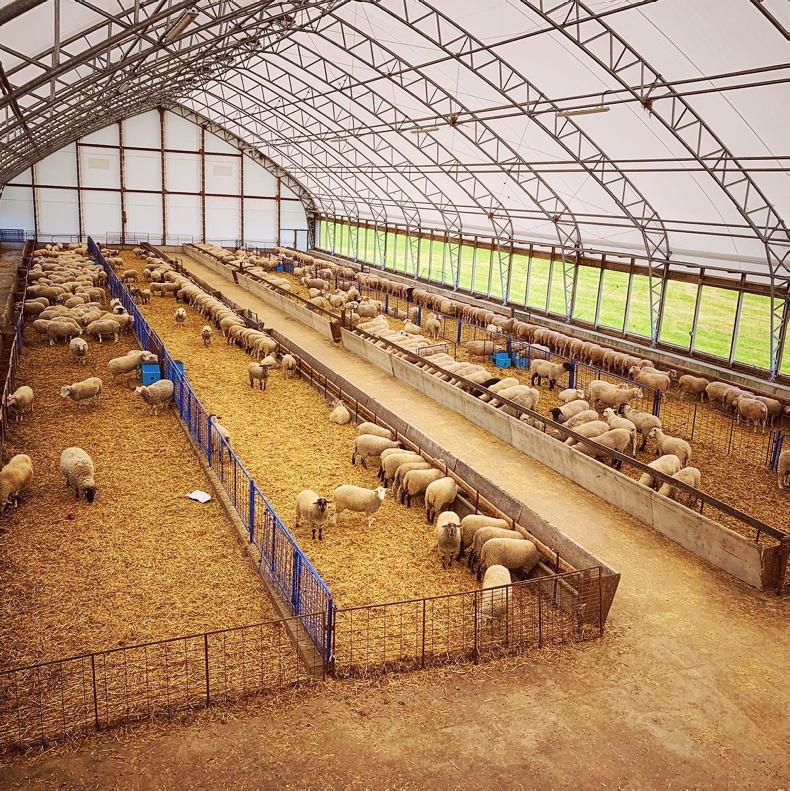
Brock's specially built sheep "barn" holds four pens of 100 to 130 ewes, with feed and water access throughout. The barn also holds a fully covered sheep handling unit, office and feedstore.
Brock's YouTube channel Sheepishly Me has had 135.1m views to date, with 1.22m of these coming from her Irish audience.
System
The flock lambs four times a year (March, June, September and December) in batches of 100 to 130 and, if on schedule, each ewe will lamb every nine months.
The Canadian breed Rideau Arcott (Rideau) makes up the base of the flock.
Sandi says the Rideau was developed at Agriculture Canada’s Animal Research Centre in Ottawa.

The Rideau Arcott ewe makes up the base of Brock's flock. Ewes are highly prolific and frequently lamb triplets and quads.
The breed is known for its high prolificacy and mothering ability, with Brock’s ewes regularly lambing triplets, quads and quintuplets at a rate of over 2.2 lambs per ewe.
“In 2015, I repopulated almost the whole flock and, recently, I’ve added a little bit of Dorset.
“My ideal ewe is a little bit of Dorset and a little bit of Rideau.”
Breeding
Sandi puts a lot of emphasis on data collection and analysis when it comes to her flock’s productivity. Lambing, milk, mothering, weaning and lamb finishing data is kept on each ewe and reviewed before culling decisions are made in advance of each breeding period.
Each breeding batch is synchronised or bred naturally, depending on the time of year, with Rideau, Suffolk, composite breed and Tunis rams used over a strict 21-day cycle.
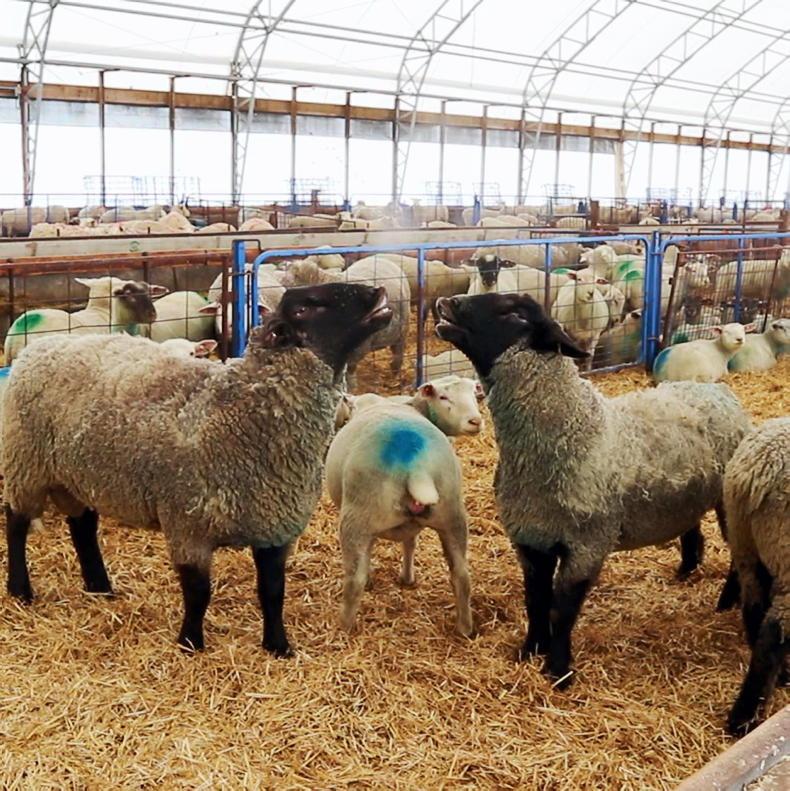
Some of the Suffolk rams in Brock's flock. Canadian Suffolks are taller sheep than those bred in Ireland and are predominantly used as a terminal sire.
A flock of over 25 rams is dispersed between a number of penned breeding groups at a ratio less than one to every five ewes.
Sandi says: “We are working a lot on nutrition with our vet. Two weeks from the day of breeding, throughout the period and for six weeks after, I put them on a flush ration. In advance of this, they’ve been on plain nutrition since weaning.”
The flock is fed a diet feeder mixture of haylage, cover crop, corn and added minerals, which is mixed depending on their stage in the production system.
Lambing
Brock described how when the ewes reach two weeks before lambing, they get a late gestation or “close-up” ration.
“They need a dense feed with all their nutrients or I find they go down with pregnancy toxaemia, especially the ewes carrying multiples. Lambing is then 21 days start to finish.”
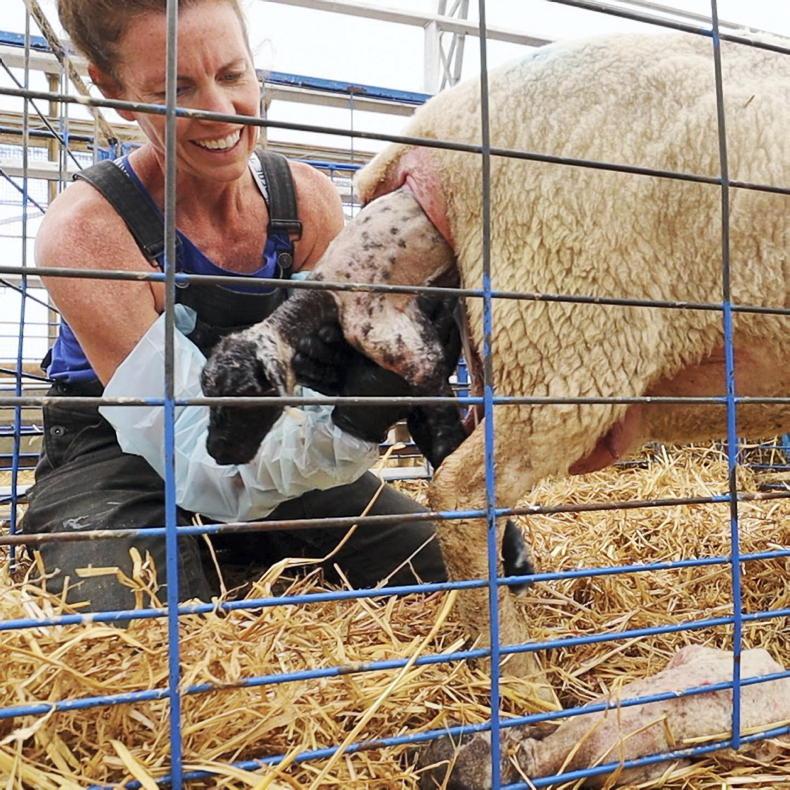
In her YouTube videos, Brock demonstrates lambing up close.
She runs an efficient lambing system where lambing “jugs” (pens) move along the lambing pen, with the “left to lamb” pen getting smaller with each ewe lambed and a new pen starting at the other end for ewes and lambs once out of the jugs.
Despite the milking ability of the Rideau, any ewe that has triplets or quads is left with two lambs only.
“Bottle babies” are reared by an artificial milk feeder, with sometimes as many as 30 to 40 lambs reared in this way for each lambing group.
Each lamb receives colostrum, iodine and a shot of selenium due to a lack of the mineral in the farm’s soil.
Lambs are also tagged, weight recorded and entered into Brock’s mobile data recording system.

A Rideau-cross lamb on Brock's farm.
“Ewes go on a lactating ration immediately. It helps that I come from a dairy and poultry background and we’re very concerned with flock health.
“From those systems, you learn a lot about the law of averages and average daily gains.”
Sandi said that while she might micro manage, she sees it as an essential part of her farm’s profitability.
Weaning
Lambs are introduced to a creep area while still on the ewe and are given access to regular fresh water.
Sandi described how at eight weeks the lambs are weaned and go to a separate finishing barn for a hay and feed ration.
She said it “makes for a nice system”, with each weaned batch of lambs moving on in sufficient time to allow pen clean-out and lead-in for the next lambing group.

Ewes receive a diet feeder mixed ration which is then fed through a "feed cart".
To finish, lambs receive a ration of dry whole corn with a 25% protein supplement and are sold almost year-round at a sale barn, once they reach 105lb (48kg).
Sandi keeps all her own replacements, selected from her significant data recording and a physical examination. Most ewe lamb groups are brought into the system to lamb at 14 months.
YouTube
The Canadian farmer said that in 2017 when she was “doing SnapChat and Instagram” she was getting more and more questions and requests to “tell me more”.
“I was sitting on farming boards and we were always discussing ways to connect with the consumer.”
She said “everyone wants to put a bright shiny face” on farming and that this creates a falsehood which leads to public upset when they see unfavourable content from the anti-farming lobby.
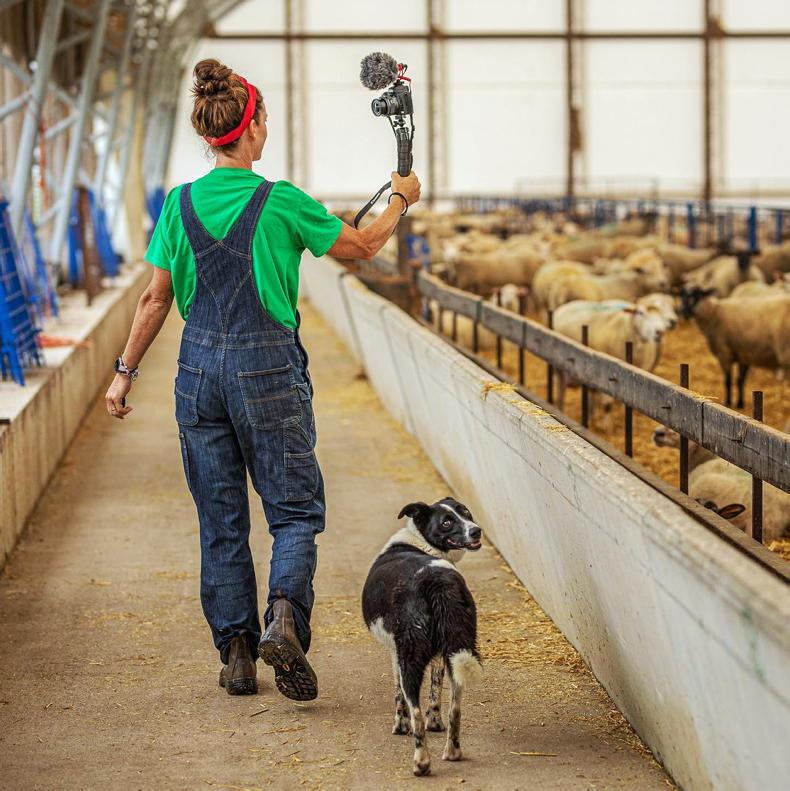
Brock's camera is kept in hand to record day-to-day sheep farming.
She said by setting up her YouTube channel, she aimed to “cultivate empathy” with non-farming followers.
“It was my mission to show people this is what sheep do, it’s ridiculous, there’s 24-hour days, they stay alive and they don’t.”
She said many farmers insist the wider public should just “trust us” when it comes to food production.
“Why should they trust us? We have to first take people with us.”
Content
Despite farming full time, Sandi is a prolific content developer. She releases videos two to three times a week and on some of the busiest times of the year, this can become daily.
Each YouTube video is 20 to 30 minutes long, with those released only in recent days reaching 100,000 views and some go as far as 3.2m. Her weekly video views during her recent December lambing reached almost 6m.
Content includes lambing, breeding and “sheep chores”, which include foot paring, lamb drafting, sheering and scanning.
Diversification
Sandi described the process behind each video being auctioned off for ads.
“It has become a third income to add to the tillage and sheep incomes on our farm, but it is a very unreliable thing.”
She said it takes a lot of videos to get YouTube to understand you and to connect you to the right ad company, but that it was an unexpected way to diversify farm income.
“This year, it was significant enough to feel like I’m justifying the time I’m putting into it.”
She said she has been able to hire part-time farm labour because of the channel.
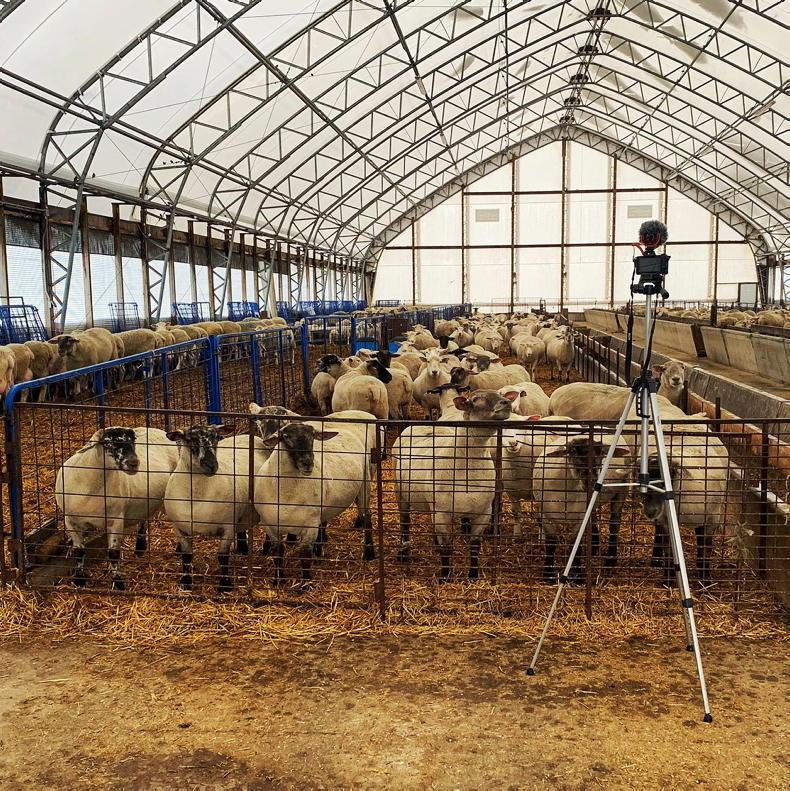
The ewes on Brock's farm are filmed most days.
Sandi and husband Mark hope to also use the additional revenue to be able to retire financially sufficient in the next few years in order to allow their children to take on the farm.
“We hope this channel will continue to open doors for us that we can live off.
“The one caveat I will say is without the sheep, or the farm, there is no channel. So as much as it’s a nice diversification, it doesn’t exist without the farm so the farm is always top priority.”
On why Irish farmers should follow her farming journey, Sandi said: “If you want a laugh and you want to know what not to do, follow me.”
Readers can find Sandi Brock on YouTube by searching her own or her channel’s name, Sheepishly Me.
Sandi Brock, a Canadian sheep farmer, lambs four times a year in a fully indoor 450-ewe system and brings her 440,000 YouTube followers on the journey.
Brock, her husband Mark, son Jack (21) and daughter Jessica (19), run a tillage and sheep farm in Ontario, Canada.
She has documented her family’s farming life on YouTube since spring 2017 and says the money it now makes her will enable her and Mark to retire and leave the farm to their children in the near future.

Brock's specially built sheep "barn" holds four pens of 100 to 130 ewes, with feed and water access throughout. The barn also holds a fully covered sheep handling unit, office and feedstore.
Brock's YouTube channel Sheepishly Me has had 135.1m views to date, with 1.22m of these coming from her Irish audience.
System
The flock lambs four times a year (March, June, September and December) in batches of 100 to 130 and, if on schedule, each ewe will lamb every nine months.
The Canadian breed Rideau Arcott (Rideau) makes up the base of the flock.
Sandi says the Rideau was developed at Agriculture Canada’s Animal Research Centre in Ottawa.

The Rideau Arcott ewe makes up the base of Brock's flock. Ewes are highly prolific and frequently lamb triplets and quads.
The breed is known for its high prolificacy and mothering ability, with Brock’s ewes regularly lambing triplets, quads and quintuplets at a rate of over 2.2 lambs per ewe.
“In 2015, I repopulated almost the whole flock and, recently, I’ve added a little bit of Dorset.
“My ideal ewe is a little bit of Dorset and a little bit of Rideau.”
Breeding
Sandi puts a lot of emphasis on data collection and analysis when it comes to her flock’s productivity. Lambing, milk, mothering, weaning and lamb finishing data is kept on each ewe and reviewed before culling decisions are made in advance of each breeding period.
Each breeding batch is synchronised or bred naturally, depending on the time of year, with Rideau, Suffolk, composite breed and Tunis rams used over a strict 21-day cycle.

Some of the Suffolk rams in Brock's flock. Canadian Suffolks are taller sheep than those bred in Ireland and are predominantly used as a terminal sire.
A flock of over 25 rams is dispersed between a number of penned breeding groups at a ratio less than one to every five ewes.
Sandi says: “We are working a lot on nutrition with our vet. Two weeks from the day of breeding, throughout the period and for six weeks after, I put them on a flush ration. In advance of this, they’ve been on plain nutrition since weaning.”
The flock is fed a diet feeder mixture of haylage, cover crop, corn and added minerals, which is mixed depending on their stage in the production system.
Lambing
Brock described how when the ewes reach two weeks before lambing, they get a late gestation or “close-up” ration.
“They need a dense feed with all their nutrients or I find they go down with pregnancy toxaemia, especially the ewes carrying multiples. Lambing is then 21 days start to finish.”

In her YouTube videos, Brock demonstrates lambing up close.
She runs an efficient lambing system where lambing “jugs” (pens) move along the lambing pen, with the “left to lamb” pen getting smaller with each ewe lambed and a new pen starting at the other end for ewes and lambs once out of the jugs.
Despite the milking ability of the Rideau, any ewe that has triplets or quads is left with two lambs only.
“Bottle babies” are reared by an artificial milk feeder, with sometimes as many as 30 to 40 lambs reared in this way for each lambing group.
Each lamb receives colostrum, iodine and a shot of selenium due to a lack of the mineral in the farm’s soil.
Lambs are also tagged, weight recorded and entered into Brock’s mobile data recording system.

A Rideau-cross lamb on Brock's farm.
“Ewes go on a lactating ration immediately. It helps that I come from a dairy and poultry background and we’re very concerned with flock health.
“From those systems, you learn a lot about the law of averages and average daily gains.”
Sandi said that while she might micro manage, she sees it as an essential part of her farm’s profitability.
Weaning
Lambs are introduced to a creep area while still on the ewe and are given access to regular fresh water.
Sandi described how at eight weeks the lambs are weaned and go to a separate finishing barn for a hay and feed ration.
She said it “makes for a nice system”, with each weaned batch of lambs moving on in sufficient time to allow pen clean-out and lead-in for the next lambing group.

Ewes receive a diet feeder mixed ration which is then fed through a "feed cart".
To finish, lambs receive a ration of dry whole corn with a 25% protein supplement and are sold almost year-round at a sale barn, once they reach 105lb (48kg).
Sandi keeps all her own replacements, selected from her significant data recording and a physical examination. Most ewe lamb groups are brought into the system to lamb at 14 months.
YouTube
The Canadian farmer said that in 2017 when she was “doing SnapChat and Instagram” she was getting more and more questions and requests to “tell me more”.
“I was sitting on farming boards and we were always discussing ways to connect with the consumer.”
She said “everyone wants to put a bright shiny face” on farming and that this creates a falsehood which leads to public upset when they see unfavourable content from the anti-farming lobby.

Brock's camera is kept in hand to record day-to-day sheep farming.
She said by setting up her YouTube channel, she aimed to “cultivate empathy” with non-farming followers.
“It was my mission to show people this is what sheep do, it’s ridiculous, there’s 24-hour days, they stay alive and they don’t.”
She said many farmers insist the wider public should just “trust us” when it comes to food production.
“Why should they trust us? We have to first take people with us.”
Content
Despite farming full time, Sandi is a prolific content developer. She releases videos two to three times a week and on some of the busiest times of the year, this can become daily.
Each YouTube video is 20 to 30 minutes long, with those released only in recent days reaching 100,000 views and some go as far as 3.2m. Her weekly video views during her recent December lambing reached almost 6m.
Content includes lambing, breeding and “sheep chores”, which include foot paring, lamb drafting, sheering and scanning.
Diversification
Sandi described the process behind each video being auctioned off for ads.
“It has become a third income to add to the tillage and sheep incomes on our farm, but it is a very unreliable thing.”
She said it takes a lot of videos to get YouTube to understand you and to connect you to the right ad company, but that it was an unexpected way to diversify farm income.
“This year, it was significant enough to feel like I’m justifying the time I’m putting into it.”
She said she has been able to hire part-time farm labour because of the channel.

The ewes on Brock's farm are filmed most days.
Sandi and husband Mark hope to also use the additional revenue to be able to retire financially sufficient in the next few years in order to allow their children to take on the farm.
“We hope this channel will continue to open doors for us that we can live off.
“The one caveat I will say is without the sheep, or the farm, there is no channel. So as much as it’s a nice diversification, it doesn’t exist without the farm so the farm is always top priority.”
On why Irish farmers should follow her farming journey, Sandi said: “If you want a laugh and you want to know what not to do, follow me.”
Readers can find Sandi Brock on YouTube by searching her own or her channel’s name, Sheepishly Me.















 This is a subscriber-only article
This is a subscriber-only article










SHARING OPTIONS: